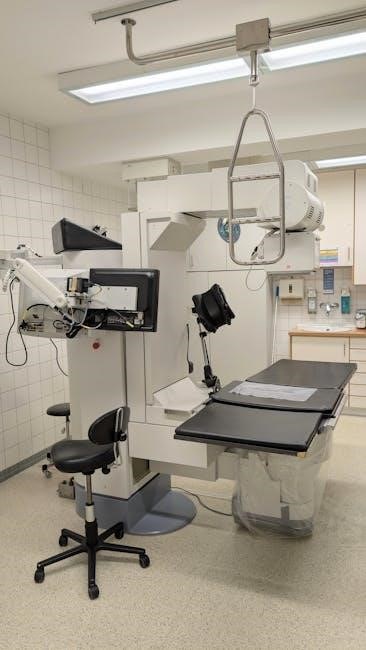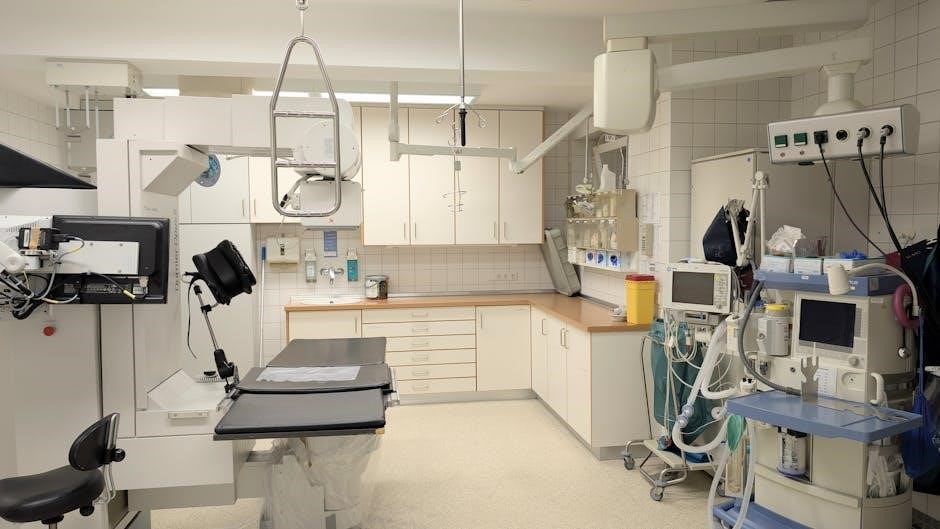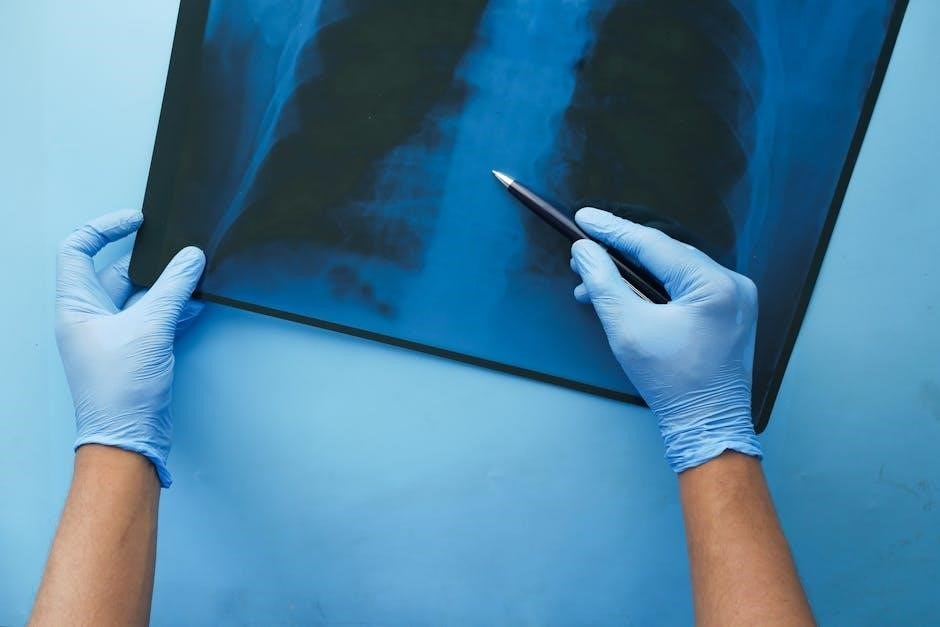Hip fracture rehabilitation is a critical process aimed at restoring functional mobility and improving quality of life after surgery. It involves evidence-based practices, multidisciplinary teams, and tailored interventions to address physical and cognitive challenges, ensuring optimal recovery and independence for patients.
1.1 Definition and Importance of Hip Fracture Rehabilitation
Hip fracture rehabilitation is a specialized care process designed to restore mobility, strength, and independence in patients following hip fracture surgery. It is crucial for improving quality of life, reducing disability, and enabling patients to return to their pre-injury functional status. The process involves a coordinated approach, incorporating physical and occupational therapies, to address physical limitations and promote overall recovery. Effective rehabilitation is essential for minimizing long-term complications and ensuring patients regain their ability to perform daily activities safely and effectively.
1.2 Overview of the Rehabilitation Process
The rehabilitation process for hip fractures is a structured, phased approach tailored to individual patient needs. It begins with immediate post-surgical care, focusing on pain management and initial mobilization. Following this, patients progress through acute care, early mobilization, post-acute rehabilitation, and long-term recovery. Each phase incorporates targeted therapies, including physical and occupational exercises, to enhance functional mobility and strength. The process emphasizes early ambulation, weight-bearing exercises, and functional activities to ensure a smooth transition from hospital to home, promoting independence and reducing the risk of future complications.
1.3 Goals of Rehab: Functional Mobility and Quality of Life
The primary goals of hip fracture rehabilitation are to restore functional mobility, enhance strength, and improve overall quality of life. Rehabilitation aims to help patients regain independence in daily activities, such as walking, sitting, and transferring, while minimizing pain and disability. Structured exercise programs, including progressive resistance and balance training, are essential to achieve these objectives. Additionally, addressing psychological and social factors contributes to a holistic recovery. The ultimate goal is to enable patients to return to their pre-fracture level of function, reducing the risk of future complications and promoting long-term well-being.

Phases of Hip Fracture Rehabilitation
Hip fracture rehabilitation is divided into distinct phases, including immediate post-surgical care, early mobilization, post-acute recovery, and long-term maintenance, each tailored to promote progressive recovery and independence.
2.1 Phase I: Immediate Post-Surgical Phase (Day 1-28)
Phase I focuses on stabilization and initial recovery post-surgery. Patients undergo pain management, wound care, and basic mobilization, such as transferring from bed to chair. Physical therapists assist with gentle exercises to maintain range of motion and prevent complications like deep vein thrombosis. This phase emphasizes patient safety and comfort, setting the foundation for more active rehabilitation in subsequent stages. Early mobilization strategies are introduced to prepare the patient for progressive recovery.
2.2 Phase II: Acute Care and Early Mobilization
2.3 Phase III: Post-Acute Rehabilitation
Phase III focuses on advancing strength, balance, and functional abilities. Patients transition to outpatient or home-based therapy, emphasizing progressive exercises and activities of daily living. Weight-bearing exercises and resistance training are intensified to improve mobility and reduce reliance on assistive devices. This phase also introduces low-impact aerobic exercises to enhance endurance. Clinicians monitor progress using outcome measures like the New Mobility Score to tailor interventions. The goal is to maximize independence and prepare patients for long-term recovery, ensuring a smooth transition to maintenance and community integration.
Phase III focuses on advancing strength, balance, and functional abilities. Patients transition to outpatient or home-based therapy, emphasizing progressive exercises and activities of daily living. Weight-bearing exercises and resistance training are intensified to improve mobility and reduce reliance on assistive devices. This phase also introduces low-impact aerobic exercises to enhance endurance. Clinicians monitor progress using outcome measures like the New Mobility Score to tailor interventions. The goal is to maximize independence and prepare patients for long-term recovery, ensuring a smooth transition to maintenance and community integration.
2.4 Phase IV: Long-Term Recovery and Maintenance
Phase IV emphasizes sustaining functional gains and promoting lifelong health. Patients engage in personalized exercise programs, focusing on strength, flexibility, and balance. This phase highlights adherence to home exercises, proper nutrition, and fall prevention strategies. Regular monitoring ensures continued progress and addresses any emerging challenges. The goal is to support long-term independence, reduce recurrence risks, and improve overall well-being, integrating patients back into their communities with confidence and capability.

Clinical Guidelines for Hip Fracture Rehabilitation
Clinical guidelines provide evidence-based recommendations for rehabilitation, ensuring optimal care and recovery. They emphasize early mobilization, structured therapies, and multidisciplinary approaches to address patient-specific needs effectively.
3.1 Clinical Practice Guidelines (CPGs) Overview
Clinical practice guidelines (CPGs) for hip fracture rehabilitation provide evidence-based recommendations to optimize recovery. They cover early mobilization, physical and occupational therapies, and comorbidity management. CPGs are developed by experts, ensuring standardized care. Key elements include structured exercise programs, progressive resistance training, and balance exercises. They emphasize multidisciplinary team collaboration and patient-centered approaches. CPGs also address postoperative care, functional assessments, and long-term recovery strategies. These guidelines adapt to individual patient needs, ensuring tailored interventions. By following CPGs, healthcare providers can improve functional outcomes and reduce complications, enhancing overall quality of life for patients post-hip fracture.
3.2 Key Recommendations from CG124/04
CG124/04 emphasizes early mobilization post-surgery, with physical therapists assisting patients in getting out of bed and moving as soon as possible. It recommends structured exercise programs, including progressive resistance and balance training. The guideline stresses the use of the New Mobility Score to assess prefracture status and recovery progress. Multidisciplinary teams are encouraged to address comorbidities and prevent complications. Intensive rehabilitation therapies, such as additional physiotherapy and occupational therapy, are evaluated for clinical and cost effectiveness. These recommendations aim to enhance functional outcomes and reduce healthcare resource utilization, ensuring efficient and effective recovery processes for hip fracture patients.
3.3 Role of Multidisciplinary Teams in Rehab
Multidisciplinary teams play a vital role in hip fracture rehabilitation, ensuring comprehensive care. These teams include physical therapists, occupational therapists, physicians, and nurses, who collaborate to address physical, emotional, and cognitive challenges. Their collective expertise promotes early mobilization, manages comorbidities, and prevents complications. By tailoring interventions to individual needs, they enhance recovery outcomes, improve functional mobility, and support patients in regaining independence. Effective communication and coordination within the team are essential for optimizing the rehabilitation process and achieving long-term goals for hip fracture patients.

Therapeutic Interventions in Hip Fracture Rehab
Therapeutic interventions include physical and occupational therapy, focusing on structured exercises, strength training, and functional mobility. Pharmacological approaches, like testosterone therapy, may also support recovery and mobility.
4.1 Physical Therapy: Structured Exercise Programs
Physical therapy plays a pivotal role in hip fracture rehabilitation through structured exercise programs. These programs typically include strength training, progressive resistance exercises, and balance activities tailored to the patient’s recovery phase. Early mobilization techniques, such as sit-to-stand exercises and ambulation with assistive devices, are emphasized to restore functional mobility. Weight-bearing exercises and high-intensity resistance training are also incorporated to enhance muscle strength and stability, particularly in the lower extremities. These interventions are often guided by clinical practice guidelines to ensure optimal outcomes and minimize complications.
4.2 Occupational Therapy: Functional Mobility Training
Occupational therapy focuses on functional mobility training to help patients regain independence in daily activities. This includes exercises to improve transfers, such as moving from a bed to a chair, and performing tasks like dressing and bathing. Home-based programs are often tailored to adapt the patient’s living environment for safety and accessibility. Caregivers are also educated to assist effectively, ensuring a smooth transition to independent living. The goal is to maximize the patient’s ability to perform everyday tasks, promoting long-term independence and quality of life post-rehabilitation.
4.3 Pharmacological Interventions: Testosterone Therapy
Testosterone therapy is explored as a pharmacological intervention to enhance recovery in older adults, particularly those with low testosterone levels. Studies, such as the STEP-HI trial, indicate that combining testosterone with exercise training shows limited improvement in mobility. While it may not significantly enhance long-term functional outcomes, it is considered for patients with specific deficiencies or comorbidities. This approach aims to address muscle wasting and improve overall strength, though its effectiveness remains debated and is typically used alongside other rehab strategies to optimize recovery and patient outcomes.

Exercise and Mobility Training
Exercise and mobility training are cornerstone interventions, focusing on early mobilization, progressive resistance, strength training, balance exercises, and functional activities like sit-to-stand and ambulation to restore independence.
5.1 Early Mobilization Techniques
Early mobilization is a cornerstone of hip fracture rehabilitation, focusing on getting patients out of bed promptly post-surgery. Techniques include assisted transfers, sit-to-stand exercises, and ambulation with assistive devices. Physical therapists guide patients in weight-bearing exercises tailored to their tolerance, aiming to enhance strength, balance, and functional independence. Early movement prevents complications like muscle atrophy and improves circulation. Structured protocols ensure safety, progressing from non-weight-bearing to full weight-bearing activities as healing allows. This phase lays the foundation for long-term recovery and mobility.
5.2 Progressive Resistance and Strength Training
Progressive resistance and strength training are essential in hip fracture rehabilitation to restore muscle strength and functional abilities. These exercises involve gradually increasing resistance to improve muscle endurance and power. Techniques include weight-bearing exercises, resistance bands, and functional activities like stair climbing. Strength training focuses on the lower extremities, core, and upper body to enhance stability and mobility. Supervised by physical therapists, these exercises are tailored to the patient’s recovery stage, promoting independence and reducing fall risk. Regular progression ensures continuous improvement, supporting long-term recovery goals.
5.3 Balance and Weight-Bearing Exercises
Balances and weight-bearing exercises are crucial for restoring stability and reducing fall risk after a hip fracture. These exercises focus on improving proprioception and strengthening muscles around the hip and lower extremities. Techniques include standing with support, single-leg stance, and heel-to-toe walking. Weight-bearing activities, such as partial weight-bearing exercises, are introduced gradually to promote bone healing and muscle activation. These exercises are often combined with functional activities like sit-to-stand transitions to enhance real-world mobility. Progression is tailored to the patient’s tolerance and recovery stage, ensuring safe and effective rehabilitation outcomes.
5.4 Functional Activities: Sit-to-Stand and Ambulation
Sit-to-stand transitions and ambulation are vital functional activities in hip fracture rehabilitation, focusing on regaining independence in daily movements. Patients learn to safely move from sitting to standing using arm support and proper body mechanics. Ambulation training begins with short distances, using assistive devices like walkers or canes, and progresses to independent walking. These exercises enhance lower extremity strength, balance, and coordination, while minimizing the risk of falls. Practice on varying surfaces and inclines further improves functional mobility and prepares patients for real-world challenges.

Clinical Assessment and Outcome Measures
Clinical assessments, such as the New Mobility Score, evaluate prefracture mobility and recovery progress, ensuring tailored interventions and monitoring functional outcomes effectively throughout rehabilitation.
6.1 Use of the New Mobility Score
The New Mobility Score is a critical tool in assessing functional mobility and recovery progress post-hip fracture. Used in early inpatient settings, it evaluates prefracture mobility status, assisting clinicians in predicting outcomes and tailoring rehabilitation plans. This score provides objective measurements of a patient’s ability to perform essential movements, such as transfers and ambulation. Regular monitoring with this score helps track improvement, ensuring interventions are adjusted to meet individual needs. It is an essential component of clinical practice guidelines, supporting effective and personalized rehabilitation strategies for optimal recovery and independence. Its application ensures consistent and reliable outcomes measurement.
6.2 Assessing Prefracture Status and Recovery Progress
Assessing prefracture status and recovery progress is vital for tailoring rehabilitation strategies. Tools like the New Mobility Score evaluate pre-injury mobility, helping predict recovery potential. Early mobilization assessments, such as sit-to-stand and ambulation, provide insights into functional abilities. Regular monitoring of strength, balance, and weight-bearing capacity ensures adjustments to treatment plans. This structured approach aligns with clinical guidelines, optimizing outcomes and promoting independence. Accurate assessments guide clinicians in addressing individual needs, fostering a patient-centered recovery process that enhances functional mobility and quality of life post-hip fracture.
6.3 Monitoring Functional Outcomes in Rehab
Monitoring functional outcomes in hip fracture rehab involves tracking progress through standardized assessments. Tools like the New Mobility Score and functional mobility training evaluations measure improvements in activities such as walking and balance. Clinicians assess the ability to perform daily tasks, like sit-to-stand and ambulation, to gauge recovery. Regular strength and weight-bearing assessments ensure safe progression. These evaluations guide adjustments to treatment plans, aligning with clinical guidelines to optimize functional recovery and long-term independence for patients.

Home-Based Rehabilitation Programs
Home-based rehab offers tailored exercises, caregiver support, and telehealth monitoring, ensuring continued progress, safety, and independence post-hospital discharge, aligning with clinical guidelines for optimal recovery;
7.1 Home Exercise Programs: Structure and Benefits
Home exercise programs are structured to include functional activities like sit-to-stand, step climbing, and balance exercises, promoting strength and mobility. Supervised by caregivers or therapists, these routines enhance adherence and safety, reducing the risk of falls. Benefits include improved physical function, accelerated recovery, and greater independence, with studies showing enhanced long-term mobility in older adults. Consistency is key to achieving optimal outcomes and preventing future fractures, aligning with clinical guidelines for effective home-based rehabilitation.
7.2 Role of Caregivers in Home-Based Rehab
Caregivers play a vital role in home-based rehabilitation by assisting patients with daily exercises, monitoring progress, and ensuring safety. They help with functional activities like sit-to-stand and ambulation, providing emotional support and encouragement. Caregivers also manage schedules, remind patients to perform exercises, and communicate with healthcare providers. Their involvement fosters a supportive environment, promoting adherence to rehab protocols and enhancing recovery outcomes. Proper training for caregivers is essential to ensure effective assistance and patient safety during the rehabilitation process.
7.3 Wearable Technology and Remote Monitoring
Wearable technology and remote monitoring are transforming home-based rehabilitation by enabling real-time tracking of patient progress. Sensors and mobile apps monitor adherence to exercise programs, offering feedback on technique and intensity. GPS tracking ensures patients perform outdoor activities safely. Remote monitoring allows therapists to adjust protocols without in-person visits, enhancing accessibility and efficiency. This technology also integrates with electronic health records, providing a comprehensive view of recovery. Wearables promote personalized care, empowering patients to take an active role in their rehabilitation while reducing the need for frequent clinic visits.

Managing Comorbidities and Complications
Managing comorbidities and complications is crucial for optimizing recovery outcomes in hip fracture patients, requiring tailored strategies to address pre-existing conditions and prevent further health deterioration.
8.1 Rehabilitation Considerations for Older Adults
Elderly patients with hip fractures often face unique challenges due to comorbidities, such as osteoporosis or cognitive impairments. Rehabilitation must be tailored to address these factors, ensuring safe and effective recovery. Early mobilization and weight-bearing exercises are prioritized to prevent complications like pressure sores or deep vein thrombosis. Physical therapists play a key role in designing programs that accommodate limited mobility and strength. Additionally, caregivers are essential in supporting adherence to home-based exercises and promoting independence. These considerations aim to enhance functional outcomes and overall quality of life for older adults post-hip fracture.
8.2 Addressing Comorbid Conditions During Rehab
Managing comorbid conditions is crucial during hip fracture rehabilitation, as they can hinder recovery. Common comorbidities include diabetes, cardiovascular diseases, and cognitive impairments. A multidisciplinary team must address these conditions to optimize outcomes. For instance, medication management and monitoring of chronic diseases are essential to prevent complications. Additionally, physical therapy must be adapted to accommodate limitations imposed by comorbidities, ensuring safe and effective exercise programs. Addressing these conditions early enhances the patient’s ability to participate in rehab, improving functional recovery and overall quality of life.
8.3 Preventing and Managing Rehab-Related Complications
Rehab-related complications, such as pressure sores or infections, must be proactively managed. Early mobilization reduces immobility risks, while proper wound care prevents surgical site infections. Monitoring for signs of complications is critical. Healthcare providers should tailor interventions to minimize risks, ensuring patient safety throughout recovery. Regular assessments and adjustments to treatment plans help prevent adverse events, optimizing outcomes and supporting successful rehabilitation.

Cost-Effectiveness of Rehab Interventions
Understanding the cost-effectiveness of rehabilitation interventions is crucial for optimizing care. It evaluates the economic impact of intensive physiotherapy, occupational therapy, and healthcare resource utilization, ensuring efficient recovery outcomes.
9.1 Economic Impact of Intensive Physiotherapy
Intensive physiotherapy significantly influences the economic landscape of hip fracture rehabilitation. Studies indicate that structured exercise programs, including progressive strength training, balance, and weight-bearing exercises, reduce hospital readmissions and shorten recovery times. This leads to lower healthcare costs. The New Mobility Score is often used to assess patient progress and tailor interventions, optimizing resource allocation. Additionally, early mobilization techniques and functional activities like sit-to-stand and ambulation reduce the need for prolonged inpatient care, further cutting expenses. Cost-benefit analyses highlight the long-term financial benefits of investing in intensive physiotherapy for hip fracture patients.
9.2 Cost-Benefit Analysis of Occupational Therapy
Occupational therapy (OT) plays a crucial role in hip fracture rehabilitation, offering significant cost benefits. Functional mobility training and daily activity assistance reduce healthcare utilization by enabling earlier discharge. Home-based OT programs, supported by caregivers, minimize the need for prolonged institutional care, lowering costs. Additionally, OT interventions like sit-to-stand exercises and ambulation training enhance independence, reducing long-term care expenses. Studies show that structured OT programs yield measurable improvements in quality of life and functional outcomes, making them a cost-effective component of hip fracture rehabilitation protocols.
9.3 Healthcare Resource Utilization in Rehab
Hip fracture rehabilitation requires careful management of healthcare resources to optimize recovery and reduce costs. Home-based programs and wearable technology reduce hospital readmissions and lengths of stay. Multidisciplinary teams streamline care, minimizing redundant services. Early mobilization and structured exercises decrease the need for prolonged institutional care. Remote monitoring tools enhance efficiency, ensuring timely interventions. By integrating cost-effective strategies, healthcare systems can allocate resources more efficiently, improving patient outcomes while lowering overall expenditure associated with hip fracture rehabilitation.

Emerging Trends and Future Directions
Advances in wearable technology and telehealth are revolutionizing hip fracture rehabilitation, enabling remote monitoring and personalized care. Emerging trends focus on integrating innovative therapies and digital tools to enhance recovery outcomes and patient engagement.
10.1 Advances in Rehab Technologies
Recent advancements in rehabilitation technologies are transforming hip fracture recovery. Wearable devices now enable real-time monitoring of patient progress, while telehealth platforms provide remote therapy sessions. AI-driven tools offer personalized exercise plans, optimizing recovery trajectories. Robotics are also being integrated to assist with physical therapy, improving mobility and strength. These innovations enhance accessibility and adherence to rehab protocols, particularly for older adults. They also reduce healthcare costs by minimizing in-person visits. Such technologies are paving the way for more efficient, patient-centered care pathways in hip fracture rehabilitation.
10.2 Personalized Rehab Protocols
Personalized rehabilitation protocols are tailored to address individual patient needs, incorporating factors like age, pre-fracture mobility, and comorbidities. These protocols leverage AI-driven tools to analyze recovery progress and adjust interventions accordingly. Structured exercise programs are customized to enhance strength and balance, while functional mobility training focuses on specific patient goals. Home-based exercises and wearable technology further support adherence to personalized plans, ensuring continuous progress. This approach enhances recovery outcomes and improves patient satisfaction, making rehab more effective and sustainable in the long term. Personalization is key to achieving optimal results in hip fracture rehabilitation.
10.3 Integration of Telehealth in Hip Fracture Rehab
Telehealth integration enhances accessibility to hip fracture rehabilitation, enabling remote monitoring and virtual consultations. Wearable devices track progress, while video calls facilitate real-time guidance from therapists. This approach supports home-based exercises, improving adherence and continuity of care. Telehealth reduces hospital readmissions and expands reach to underserved populations. It complements traditional rehab by offering flexible, patient-centered solutions, ensuring consistent recovery support. This technology is particularly beneficial for older adults, promoting independence and safety during the healing process. Telehealth is revolutionizing hip fracture rehab by bridging gaps in care delivery.
